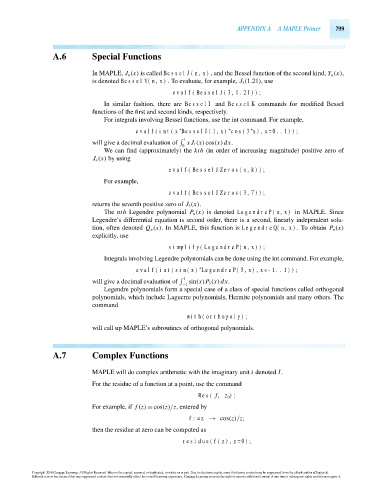Page 819 - Advanced_Engineering_Mathematics o'neil
P. 819
APPENDIX A A MAPLE Primer 799
A.6 Special Functions
In MAPLE, J n (x) is called BesselJ(n,x), and the Bessel function of the second kind, Y n (x),
is denoted BesselY(n,x). To evaluate, for example, J 3 (1.21),use
evalf(BesselJ(3,1.21));
In similar fashion, there are BesselI and BesselK commands for modified Bessel
functions of the first and second kinds, respectively.
For integrals involving Bessel functions, use the int command. For example,
∗
∗
∗
evalf(int(x BesselJ(1,x) cos(3 x),x=0..1));
1
will give a decimal evaluation of xJ 1 (x)cos(x)dx.
0
We can find (approximately) the kth (in order of increasing magnitude) positive zero of
J n (x) by using
evalf(BesselJZeros(n,k));
For example,
evalf(BesselJZeros(3,7));
returns the seventh positive zero of J 3 (x).
The nth Legendre polynomial P n (x) is denoted LegendreP(n,x) in MAPLE. Since
Legendre’s differential equation is second order, there is a second, linearly independent solu-
tion, often denoted Q n (x). In MAPLE, this function is LegendreQ(n,x). To obtain P n (x)
explicitly, use
simplify(LegendreP(n,x));
Integrals involving Legendre polynomials can be done using the int command. For example,
∗
evalf(int(sin(x) LegendreP(5,x),x=-1..1));
1
will give a decimal evaluation of sin(x)P 5 (x)dx.
−1
Legendre polynomials form a special case of a class of special functions called orthogonal
polynomials, which include Laguerre polynomials, Hermite polynomials and many others. The
command
with(orthopoly);
will call up MAPLE’s subroutines of orthogonal polynomials.
A.7 Complex Functions
MAPLE will do complex arithmetic with the imaginary unit i denoted I.
For the residue of a function at a point, use the command
Res( f, z 0 );
For example, if f (z) = cos(z)/z, entered by
f:=z → cos(z)/z;
then the residue at zero can be computed as
residue(f(z),z=0);
Copyright 2010 Cengage Learning. All Rights Reserved. May not be copied, scanned, or duplicated, in whole or in part. Due to electronic rights, some third party content may be suppressed from the eBook and/or eChapter(s).
Editorial review has deemed that any suppressed content does not materially affect the overall learning experience. Cengage Learning reserves the right to remove additional content at any time if subsequent rights restrictions require it.
October 14, 2010 15:43 THM/NEIL Page-799 27410_24_appA_p789-800

